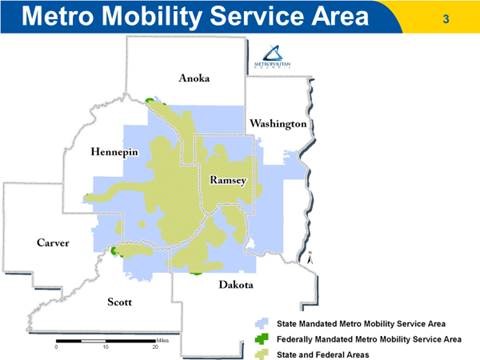Transit Link service, where there is no regular-route service, could be discontinued
Demand for Metro Mobility service continues to grow, but legislation that passed in the Minnesota House of Representatives would likely mean cuts in the transportation service for people with disabilities, as well as fare increases.
Transit Link dial-a-ride service is a discretionary program the Council provides in areas where regular-route transit service is not available. The Council would likely be forced to eliminate this service under proposed funding levels, hitting suburban areas especially hard.
As approved by the House, HF861 would increase the projected regional transit deficit from $74 million to $140 million, and fail to meet the needs of the growing disability community. The legislation would force cuts throughout Council transit services, including Metro Transit, Metro Mobility, Transit Link and other transit service under contract to the Council.
The House bill would also require fare increases throughout the transit system, above and beyond what the Council is currently considering.
For Metro Mobility, the current peak-hour fare is $4.00 per ride; $3.00 during off-peak hours. Council officials worry about the effect of further increases on a vulnerable population living on limited incomes.
Budget cuts would reduce Metro Mobility service area and hours
The House bill would fund Metro Mobility with the Motor Vehicle Sales Tax (MVST) rather than state general funds. But that doesn’t address the effects that cuts to Metro Transit service have on Metro Mobility, nor the continued growth in demand for Metro Mobility.
“Metro Transit and Metro Mobility are indivisible,” said Gerri Sutton, Assistant Director of Metropolitan Council Contracted Transit Services. “Their service areas, hours, and fares are connected."
Under the Americans with Disabilities Act (ADA), Metro Mobility service must complement regular-route local service in the region. Since regular-route service would shrink under the cuts, Metro Mobility’s service area and hours, too, would be threatened.
“To accommodate cuts in regional transit, we would need to reduce Metro Mobility service throughout the region, but suburban service could be most affected,” said Sutton.
Metro Mobility called a “lifeline” for tens of thousands
“Transit, and specifically Metro Mobility, is a lifeline for many people with disabilities, helping them get to jobs, medical appointments, social activities and other destinations,” said Kjensmo Walker, who chairs the Metropolitan Council’s Transportation Accessibility Advisory Committee.
“We rely on Metro Mobility and other transit services to interact with and participate in our communities. Reductions in the face of growing need and demand would be devastating to the disability community,” said Walker.
Metro Mobility ridership continues to grow
Demand for Metro Mobility service in the Twin Cities metro area increased nearly 6% to 2.23 million rides in 2016. That continues a trend of annual growth of 5% to 8% that is expected to continue well into the future, given a growing and aging population.
More information
Metro Mobility is on-demand service for people with disabilities, and is mandated under the ADA as well as state law. Riders must be certified for eligibility.
